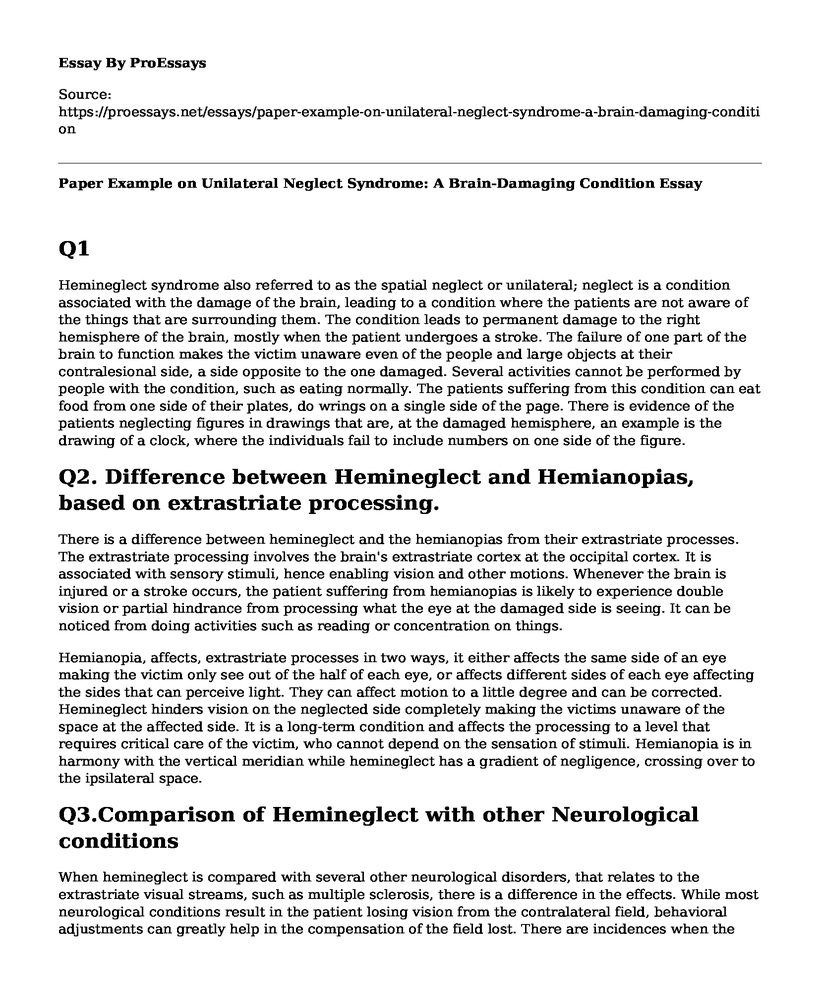Q1
Hemineglect syndrome also referred to as the spatial neglect or unilateral; neglect is a condition associated with the damage of the brain, leading to a condition where the patients are not aware of the things that are surrounding them. The condition leads to permanent damage to the right hemisphere of the brain, mostly when the patient undergoes a stroke. The failure of one part of the brain to function makes the victim unaware even of the people and large objects at their contralesional side, a side opposite to the one damaged. Several activities cannot be performed by people with the condition, such as eating normally. The patients suffering from this condition can eat food from one side of their plates, do wrings on a single side of the page. There is evidence of the patients neglecting figures in drawings that are, at the damaged hemisphere, an example is the drawing of a clock, where the individuals fail to include numbers on one side of the figure.
Q2. Difference between Hemineglect and Hemianopias, based on extrastriate processing.
There is a difference between hemineglect and the hemianopias from their extrastriate processes. The extrastriate processing involves the brain's extrastriate cortex at the occipital cortex. It is associated with sensory stimuli, hence enabling vision and other motions. Whenever the brain is injured or a stroke occurs, the patient suffering from hemianopias is likely to experience double vision or partial hindrance from processing what the eye at the damaged side is seeing. It can be noticed from doing activities such as reading or concentration on things.
Hemianopia, affects, extrastriate processes in two ways, it either affects the same side of an eye making the victim only see out of the half of each eye, or affects different sides of each eye affecting the sides that can perceive light. They can affect motion to a little degree and can be corrected. Hemineglect hinders vision on the neglected side completely making the victims unaware of the space at the affected side. It is a long-term condition and affects the processing to a level that requires critical care of the victim, who cannot depend on the sensation of stimuli. Hemianopia is in harmony with the vertical meridian while hemineglect has a gradient of negligence, crossing over to the ipsilateral space.
Q3.Comparison of Hemineglect with other Neurological conditions
When hemineglect is compared with several other neurological disorders, that relates to the extrastriate visual streams, such as multiple sclerosis, there is a difference in the effects. While most neurological conditions result in the patient losing vision from the contralateral field, behavioral adjustments can greatly help in the compensation of the field lost. There are incidences when the neurons are affected. Patients with any form of hemineglect have no incidences of lost vision. They have a failure of awareness, concerning the stimuli. Any activity of the stimuli is not relayed to the extrastriate cortex. It relates to blindsight a neurological disorder, where the victim experiences stimulation of vision in the absence of conscious awareness due to the disturbance of the visual neurons. It is more complex as it entails the destruction of the neural circuity responsible for the basic characteristics of perception.
Cite this page
Paper Example on Unilateral Neglect Syndrome: A Brain-Damaging Condition. (2023, May 08). Retrieved from https://proessays.net/essays/paper-example-on-unilateral-neglect-syndrome-a-brain-damaging-condition
If you are the original author of this essay and no longer wish to have it published on the ProEssays website, please click below to request its removal:
- Cervical Cancer Screening for Women in Cincinnati Ohio
- Organisational Changes at Mid Staffordshire Hospital Paper Example
- Essay Sample on Implementing Safeguarding and Personalisation in Social Work
- Essay Sample on Mental Illness in the Community
- Essay Sample on Embracing Change in Leadership & Nursing: Maximizing Quality
- Essay Example on Diabetic Patients at Risk of Neurological & Musculoskeletal Disorders
- Essay Example on Cardiovascular Diseases: The Leading Cause of Death Globally







